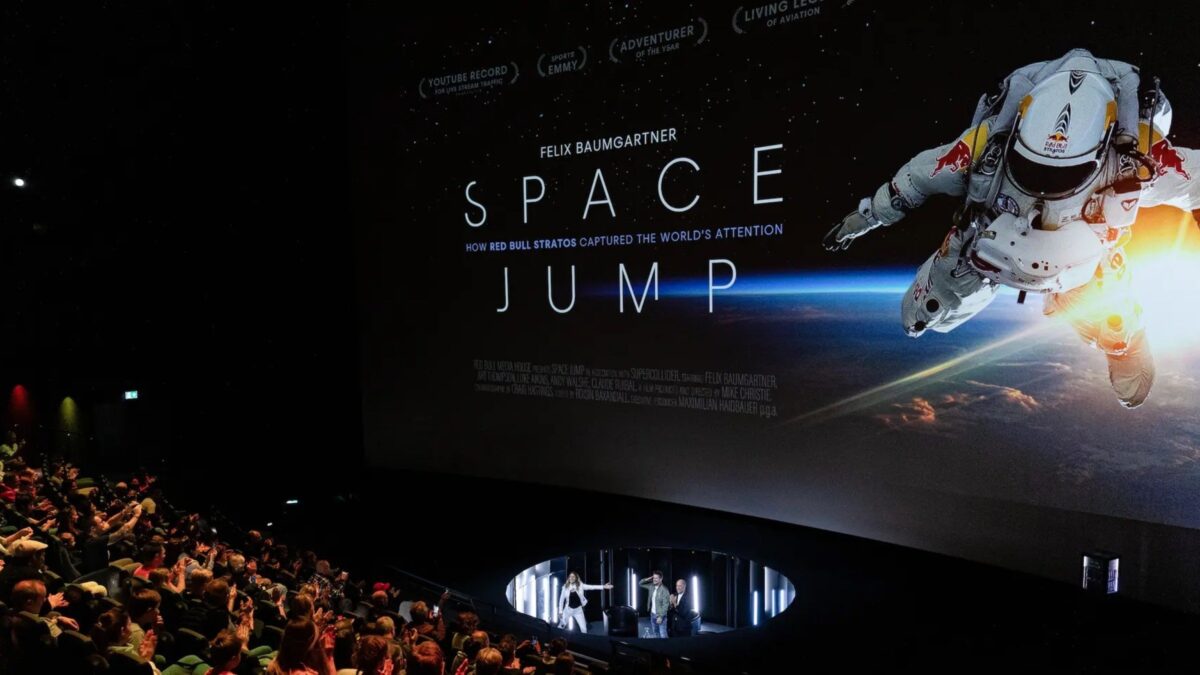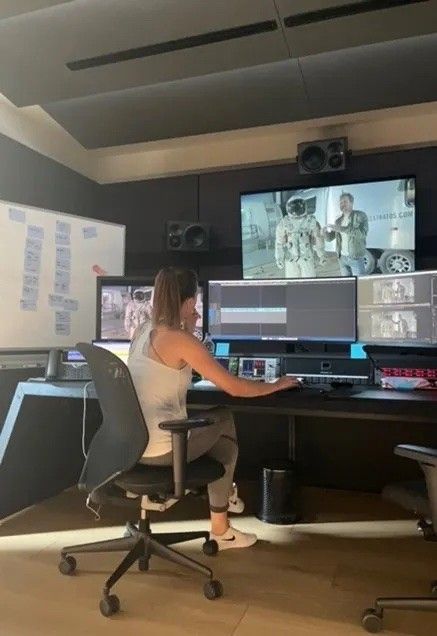
More than ten years ago on October 14th, 2012, Felix Baumgartner, an Austrian daredevil, ascended to the edge of space in a small capsule, and jumped to Earth, becoming the first human to break the sound barrier in freefall.
This post was written by Meagan Keane and originally appeared on Adobe blog on Mar. 22, 2023.
To commemorate this world record, Red Bull TV aired a new documentary, Space Jump: How Red Bull Stratos Captured the World’s Attention, on the jump’s 10th anniversary. To compile hours of archival footage, interviews, and real-time footage, the filmmakers used Adobe Premiere Pro to showcase the legacy of the mission that continues to shape the future of aeronautics and livestreaming 10 years later.
Space Jump dives into the machinations behind the jump and the gravity of it — a human falling from space faster than a bullet — all while eight million people watched live on YouTube. Through the eyes of Felix, as well as eyewitnesses and other key members of the mission team, this film revisits the incredible Red Bull Stratos mission, casting new light on the intensely personal experience of the jump itself.
“The stream nearly broke the YouTube platform’s servers, reaching 16 times that of the Summer Olympics and is still the most watched live stream in the platform’s history,” said Max Haidbauer, head of Global Athlete Content at Red Bull. “People on every corner of the globe were transfixed by the endeavor as it played out live on 77 TV channels globally, in addition to millions of online streamers.” According to Tim Katz, head of Sports and News Partnerships at YouTube, within the first few weeks, Red Bull saw over 100 million playbacks of the event. Now, ten years later, they’ve seen almost a billion views of content from Red Bull Stratos.
To celebrate this moment in history, video editor Roisin Baxandall worked tirelessly, using Premiere Productions, to gather, organize, and edit all the footage, creating a seamless and moving documentary.
“We were on an incredibly tight time schedule and were shooting new footage up to three days before the final delivery date, whilst piecing together what we could with archive and dailies in the meantime,” said Roisin Baxandall. “The main shoot was split between Europe and the US, with the post house in Salzburg, and since this was interview driven, we needed to know what we were working with as soon as possible. We worked backwards, prioritizing the transfer of audio files almost immediately after the shoot had finished, getting transcripts and editing with the audio, then syncing the video later on once the files had transferred.”
Space Jump, which aired last fall and is available to watch on the Red Bull website, is as compelling behind the screen as it is on screen. Read on to see how Baxandall compiled this commemorative documentary.
How and where did you first learn to edit?
I was studying Media Studies in College when I was around 17, and we were making a short film as part of the module. I remember thinking that learning the basics of production never interested me, but as soon as we brought the raw footage back to the lab, I was immersed in a new world of crafting. It was like a spark lit up inside of me, and I knew then that I enjoyed editing. It wasn’t until I was 21, and helping a friend put together some behind the scenes footage of a modeling shoot, that I realized I wanted to make this my career. From then on, I’ve been all-in!
How do you begin a project/set up your workspace?
Organization is key. From the get-go, we have a template for projects, which allows us to already have structured bins in place for everything we need (sequences, footage, audio, etc.). This is so helpful and time-saving, and I never start a project without it. From there, I’ll prepare sequences for selects, depending on what I need, and I’ll try and make everything as efficient as possible for the upcoming project. For Space Jump, we had a lot of archived footage to select and re-organize based on the upcoming scenes we would be cutting in the new documentary, so I tried to make sure I had as much ready as possible to find easily for when I would need it.
Tell us about a favorite scene or moment from this project and why it stands out to you.
The flatspin that Felix experienced shortly after jumping out from 128,000 feet is definitely the most dramatic moment of the entire jump. However, in real-time, the spin only lasts 15 seconds. We had to stretch it across four minutes whilst Felix re-told the experience of it. With 8 Go-Pro cameras and a long-range infra-red broadcast camera, we managed to create a watchable scene that keeps its tension throughout (I think!).
As the editor, you see the footage over and over again, and you know the story inside out, so I was always worried that this scene would feel lengthy to a general audience. But feedback from people outside of the project reassured me that this achieved exactly what we wanted it to — people felt a physical reaction to the scene and the overall story. As the project was unscripted and relied on interviews from crew members to tell the story, there was a lot of fluctuation and uncertainty about the structure of the documentary. We built the spin scene first as it was the only moment we were completely sure would be pivotal to the entire documentary.
Credit: Red Bull
What were some specific post-production challenges you faced that were unique to your project? How did you go about solving them?
We were on an incredibly tight time schedule and were shooting new footage up to three days before the final delivery date, whilst piecing together what we could with archive and dailies in the meantime. The main shoot was split between Europe and the US, with the post house in Salzburg, and since this was interview driven, we needed to know what we were working with as soon as possible. We worked backwards, prioritizing the transfer of audio files almost immediately after the shoot had finished, getting transcripts and editing with the audio, then syncing the video later on once the files had transferred. Luckily, we had a good set-up with an FTP server so file transfers, ingests, and proxy creations ran smoothly.
We also had to deal with mixed frame-rates from archival footage, different aspect ratios and resolutions, and an international delivery of the final project. There were many discussions about the final delivery format, but we decided that for optimal longevity of the final product we should up-res the archive footage and deliver the final asset in 4K, which worked well!
What Adobe tools did you use on this project and why did you originally choose them? Why were they the best choice for this project?
Naturally, Premiere Pro is the weapon of choice for a project like this. We didn’t need to utilize After Effects or Dynamic Link, but it’s always reassuring to know we can move between software easily if necessary.
What do you like about Premiere Pro, and/or any of the other tools you used?
For me, compared to other editing tools, Premiere Pro is the most user friendly and seamless tool. It’s simple, easy to use, and generally has everything you need to craft a seamless product. When you’re crunched on time and weighed down by terabytes of footage, you need to be working in a software you can trust. It’s also really easy to work collaboratively on the same project, especially with the production workspace, which was critical for us on this project. I had an assistant helping to sync rushes and build structures, and we could quickly and easily share new timelines and versions which was incredibly helpful.

Credit: Red Bull
If you could share one tip about Premiere Pro, what would it be?
I love using Match Frame as it is my most used shortcut. Once you have footage in the timeline, and you’ve gone through selects, you generally know where things are and what you’re looking for. When you need to add a missing link from a scene, or find a better shot, it’s so quick and easy to match the frame back into the asset that you know, and skim through!
Who is your creative inspiration and why?
The other editors I work with at Red Bull. It’s so inspiring to watch what everyone is creating on a regular basis and see how different all our brains, creative styles and workflows are. Each editor has their own distinct “watermark”. Ideas and inspiration are shared on a daily basis, and the collaborative atmosphere helps to drive productivity and creativity. I love the team I work with!
What’s the toughest thing you’ve had to face in your career and how did you overcome it? What advice do you have for aspiring filmmakers or content creators?
I think the toughest thing I’ve had to face is the unpredictability of work. I wouldn’t say it’s a regular 9-5 job. Sometimes you have long periods of downtime, which can be demotivating if it goes on too long. On the flip side, all of a sudden you can have a huge, time-intensive project, which consumes every moment of your working day (and sometimes personal time) up until delivery date. Editing is my passion, so I find it difficult to initiate boundaries for myself when working on certain projects, and my work-life balance can take a toll because I just want to keep going. I’ve definitely learned to make sure I rest and recuperate after big projects like this in order to prevent burn-out both physically and creatively!

Credit: Red Bull
Share a photo of where you work. What’s your favorite thing about your workspace and why?
It’s quiet when I need it to be quiet, and sociable when I’ve been in an editing hole all day and need to get out and speak to some real people! The perfect balance.














